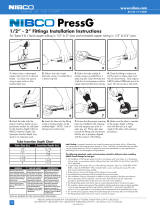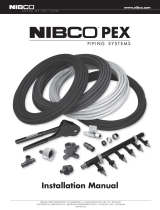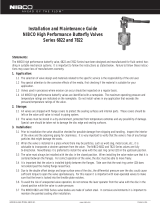
13
NIBCO INC. WORLD HEADQUARTERS • 1516 MIDDLEBURY ST. • ELKHART, IN 46516-4740 • USA • PH: 1.800.234.0227
TECH SERVICES PH: 1.888.446.4226 • FAX: 1.888.336.4226 • INTERNATIONAL OFFICE PH: +1.574.295.3327 • FAX: +1.574.295.3455
www.nibco.com
Visit our website for the most current information.
www.nibco.com
AHEAD OF THE FLOW
®
Fittings Installation Instructions
For hard or annealed ACR copper tubing
1234
1. Select clean, undamaged
copper tube and cut to
desired length using a wheel
type cutter. Do not use a
hacksaw or reciprocating
saw. Do not crimp over any
etched print on the tube.
2. Remove all external sharp
edges to the tube end. A cone
type deburring tool should
be used on the tube outer
diameter and inner diameter
(rotated 5-7 times). A pen type
deburing tool may be used
on the tube inner diameter.
It is critical to visually inspect
and feel the end of the tube
to make sure it is free of any
sharp edges which could
damage the fitting seal.
3. Polish the end of the tube
with an abrasive pad (such as
Scotch-Brite® 7447 Maroon
by 3M® or equivalent) in a
radial manner for 5-7 seconds.
Do not polish axially. The tube
end must be free from any
oxidation, dirt, debris, and any
imperfections. The surface of
the tube should be shiny and
bright. If sandpaper or emery
cloth must be used, polish with
360-400 grit.
4. Inspect the polished tube
end for any imperfections
or scratches. Any surface
imperfection that cannot be
corrected must be cut-off
and the tube preparation
restarted.
Note: PressACR fittings can only be installed with NIBCO PressACR
jaws. Use of any other jaw will void the product warranty.
Not suitable for use with ammonia (R717).
Visit www.NIBCO.com for approved list of refrigerants.
Leak Testing: Once all fittings are installed and pressed, the
system may be tested for leaks. Testing for leaks should consist of
pressurizing the system with nitrogen and using leak detect fluid
or tracer gas to detect leaks. Pressurize system to a minimum of
50% of the maximum rated pressure of the system, but no more
than 700 PSI. Check the system for leaks and make repairs/
replacements where necessary, and verify.
Tube Insertion Depth Chart
Tube Size (In. OD) Insertion Depth (In.)
1/4 – 3/4 11/16
7/8 – 1-1/8 7/8
1-3/8 1
WARNING ADVERTENCIA
Read press tool operator’s manual and
tting manufacturer’s installation in-
structions before using. Failure to follow
all instructions may result in extensive
property damage and/or serious personal
injury. Call the NIBCO Technical Service
Department at 1.888.446.4226 if you have
any questions or need assistance.
Antes de usar, lea el Manual del Operario de
esta herramienta de presión y las instruc-
ciones de instalación del acopliamiento
proporcionadas por su fabricante. Pueden
ocurrir daños materiales de gran envergadu-
ra y lesiones corporales de gravedad si no
se respetan todas las instrucciones. Si tiene
alguna pregunta o desea pedir un manual,
llame al Departamento de Servicio Técnico
de NIBCO al 1.888.446.4226.
MISE EN GARDE !
Familiarisez-vous avec le mode d’emploi
de la presse et les instructions du
fabricant des raccords avant d’utiliser
l’appareil. Le non-respect de leurs con-
signes risquerait d’augmenter les risques
de dégâts matériels importants et/ou de
graves blessures corporelles. Veuillez
adresser toutes questions éventuelles ou
demandes de mode d’emploi à la NIBCO
en composant le 1.888.446.4226.
NIBCO, INC NIBCO, INC NIBCO, INC
5
5. Mark the tube with the
proper insertion depth using
a NIBCO insertion depth tool
and a permanent marker.
Improper insertion depth may
result in an improper seal.
678910
6. Check each opening of
the fitting to make sure that
the seal is in place. Only
original NIBCO gray HNBR
seals are to be used. Do not
use a fitting that does not
have a visible seal.
7. Insert the tube into the fitting
using a twisting motion to the
marked depth. Note that the
tubing should contact the fitting
tube stop. If tube is difficult
to insert, some refrigerant
lubricant may be added to
the seal. Use only approved
lubricants as listed on page
10 of the PressACR catalog.
8. Ensure that the proper
pressing jaws are installed in
the pressing tool and squeeze
jaw arms to open jaw set.
Place open jaws around the
fitting end and ensure the jaw
is properly aligned with the
contour of the fitting. For sizes
1-1/8” and above, the jaw
has a pipe side and bead
side orientation.
9. Before pressing, make
sure that the tube is inserted to
the proper depth in the fitting.
Start the pressing process.
Refer to the tool operating
instructions for proper tool
operation. Squeeze jaw arms
to open jaw set and remove
from the pressed tube fitting
assembly.
10. Use the NIBCO PressACR
Crimp Gauge to ensure a
quality installation. Place
the crimp gauge adjacent
to the outside of the bead
(copper tube side) where the
jaws close. There should be
a slight copper deformation
in that location. If the gauge
is in complete contact with
the fitting, the crimp has been
successful. Each pressed
connection should be gauged
using the crimp gauge.
Revised 6/30/2023
NIBCO® PressACR® — Fitting Installation Instructions








